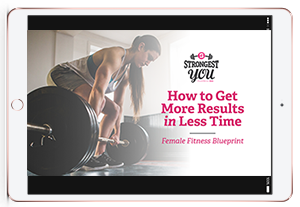How many times have you “set a goal,” only to not reach it and then feel disappointed in yourself?
This has happened to most of us, and the problem with goal achievement isn’t usually that we “failed” or “didn’t work hard enough” — it’s that our goals weren’t clear and descriptive enough to offer us an effective road map to the end result.
The goals that you set should be a helpful way for you to nail down exactly what you want to achieve and how to get there. Your goals should offer you ways to monitor your progress along the way. In this article, we’ll teach you exactly how to set yourself up for success.
Outcome-Based Goals
When most people set goals, they choose an outcome they’d like to reach. Outcome-based goals focus on the end-result, and are often number-oriented. These types of goals are very familiar to us, and they’re easy to identify. Losing twenty pounds, squatting your bodyweight, doing five chin-ups are all outcome-based goals.
Unfortunately, outcome-based goals sole focus is on the result, and these goals often leave out the most important details and step-by-step instructions. The most common experience in attempting to achieve an outcome-based goal includes:
 Getting frustrated when it’s difficult to make progress toward your goal.
Getting frustrated when it’s difficult to make progress toward your goal.- Feeling like you just have to “work harder” when you fail to reach your goal.
- Starting to believe something is wrong with you when you work harder and still don’t reach your goal, and feeling overwhelmed with the process.
The good news is, you’re not a failure and there’s nothing wrong with you. Rather, your outcome-based goal has failed you and it needs some revamping. Here’s why.
Outcome-based goals don’t leave you 100% in control of achieving them.
The things you can do are to create the conditions and behaviors that make your outcome more likely. For example, if you have a goal of squatting your bodyweight, but you do random workouts and don’t have a training program that includes squatting or other exercises that might help you increase the amount of weight you can squat, part of your road map to goal achievement is missing.
Using a training program that is progressive, includes squatting as a main exercise, and that you do a few times each week consistently over a period of months will make it more likely for you to achieve your goal of squatting your bodyweight.
Outcome-based goals might be unrealistic or lead to feelings of overwhelm.
Sometimes outcome-based goals can feel really far away and although the end result is something you really want to reach, the process of getting there might seem insurmountable, especially if your road map isn’t clear.
For example, let’s say you’ve never exercised with consistency before and are really hoping to get in shape by starting to train and by changing the way you eat. Overhauling your life might include making sweeping changes to the way you exercise, shop and prepare your food, plan your daily, weekly, and monthly schedules, and how you prioritize your rest, recovery, and self-care.
This requires making a ton of changes, some of which probably aren’t realistic or sustainable if you’re just getting started, which feeds feelings of overwhelm. These feelings of overwhelm might actually be a barrier to even getting started.
Outcome-based goals don’t necessarily address the root cause for wanting change, which makes it hard to identify concrete steps that align with your values.
Many of us assume that achieving a particular outcome will lead to increased happiness and satisfaction, which is often not the case. Just because you reach a goal you’ve set for yourself doesn’t mean you’ll feel satisfied with the results, especially if you haven’t figured out exactly why you wanted to make that change in the first place.
For example, some women want to change their body composition by losing a significant amount of body fat. When some women do achieve their goal, they still feel unsatisfied if their body doesn’t look or feel the way they expected it to.
They might feel shame because they were chasing a “look” that they thought would bring about a certain feeling or emotional state. They assumed that being leaner would make them happier. What they didn’t do was figure out exactly why they wanted to be leaner in the first place.
All of this seems frustrating, right? So what’s the solution? Set behavior-based goals that lead you toward a desired outcome.
Behavior-Based Goals
Behavior-based goals are a stronger alternative to outcome-based goals, and provide you the roadmap of actions you can take that lead you toward the results you’re chasing. These types of goals put you in the driver’s seat and more in control of the process of reaching your goal. In fact, the entire focus of behavior-based goals is the process itself.
 By digging into exactly what you want to achieve (your outcome) and why it’s important to you, it’ll be easier to identify the steps that make goal achievement more likely.
By digging into exactly what you want to achieve (your outcome) and why it’s important to you, it’ll be easier to identify the steps that make goal achievement more likely.
If you know why something’s important to you, you should be able to evaluate what you’re willing (or not willing to do) to get there. This puts you in control of your actions and behaviors and gives you a systematic way of achieving your goal. The process of goal achievement should feel less overwhelming and more satisfying because you’re becoming the person who “does the things” to reach your goal.
This approach typically allows you to have a more positive mindset along the way because you’re consistently racking up small “wins” when you take each small step toward your goal. All of these things lead you to experiencing more success.
Big Rocks vs. Small Rocks
When looking to identify behavior-based goals, we suggest that you focus first on what we consider the “big rocks,” which form the foundation of a healthy lifestyle. Big rocks include getting adequate restorative sleep, drinking enough water, managing stress, eating nourishing food, moving meaningfully, and doing these things consistently. The idea is that if you can’t consistently practice these habits, then the “small rocks” (such as choosing to add cream to your coffee or not) won’t impact your ability to get results as much as the “big rocks” will.
So, how do you set a behavior-based goal?
1. Identify Your Outcome Goal
Determine the long-range thing you’d like to achieve, and think about why it’s important to you. How do you think you’ll feel by achieving it? Does it align with the resources (time, energy, money, etc.) that you have available, and with your values and priorities? If so, move on to step two.
2. Assess What You’re Doing
Next, do an assessment of what you’re doing currently that is moving you toward that outcome. List things that might be challenging for you along the way, as well as the areas you are confident making changes. Where are the opportunities you can make small, realistic changes that move you toward your goal?
3. Choose Next Steps
Create realistic, actionable behavior-based goals that lead to your outcome. Each of these little steps acts as a rung on the ladder that leads to your goal. Each step might seem small, but all together they take you closer to where you want to go.
4. Prioritize
Rank your confidence based on the frequency you’ll need to take each action and the resources you have. Prioritize the actions you’ll take first, and remember to make small changes one at a time.
5. Track Your Progress
Choose a method for tracking your behavior-based goals in order to monitor your progress. This may be a simple check mark in a notebook, or you may choose something like an app to keep track of your changes.
6. Start With The First Behavior-Based Goal
Start tracking one behavior-based goal. On a confidence scale of 1 to 10 you should feel like you are at a 9 or 10 out of 10 that you can complete that behavior. Track for two weeks and then evaluate for consistency. If you completed that behavior 80 percent of the time over the previous two weeks, choose a new action to start tracking.
If you didn’t reach 80 percent consistency with that behavior, do a check-in to assess whether it was really realistic for you. If it’s something you’d like to continue monitoring for a while longer, go for it. If it was originally unrealistic, scale it down to something you can definitely do.
If you’ve identified an outcome-based goal, such as getting started with a training program, improving your max strength, gaining muscle mass, or getting leaner, we’ve got your road map ready for you. Our newest Get Results series of training programs provides evidence-based information on recovery, nutrition, mindset, and self-care to help you reach ANY health and fitness goals you have.
Coaches’ Corner
As a coach or trainer, your clients are going to come to you with their goals. It’s your job to help them translate outcome-based goals into actionable behavior-based goals. You can do this by helping them:
 Figure out why that goal is meaningful or important to them.
Figure out why that goal is meaningful or important to them.- Identify whether that goal aligns with their priorities and values.
- Clarify and refine concrete and manageable actions they can take.
- Manage their time by guiding where to place their energy.
As a coach, the process for taking a goal from outcome to behaviors looks like this.
- Assess your client’s current training, nutrition, rest and recovery strategies. Take a look at their lifestyle, work schedule, leisure activities, commitments, and weekly schedule. Discuss what they might be ready to change, as well as the barriers they might encounter.
- Set behavior-based goals based on their outcome goals, and keep in mind that the actions they take to move them toward their outcome have a lot to do with “big rocks” and less to do with “small rocks.” Big rocks include getting adequate restorative sleep, drinking enough water, managing stress, eating nourishing food, moving meaningfully, and doing these things consistently. Big rocks move the dial, while small rocks are very small, nuanced actions that won’t make much difference in goal achievement unless the big rocks are in place.
- Guide the small changes your client will make first. Make sure they rank their confidence level that they can do those small changes as a 9 or 10 out of 10. Help them create routines to make these actions more likely.
- Stay involved throughout the process of goal achievement and evaluate their progress. Help them through stalls in progress, over roadblocks, and problem-solve when they’re feeling challenged.
A message from GGS…
Understanding how to get more results in less time so you actually enjoy exercise and can have a life outside of the gym isn’t hard, you just have to understand the Blueprint and be willing to trust the process.

- How much you should exercise
- What to do for exercise
- How to put it all together into a plan that works for YOU
The good news? It’s simpler than you think!
Tell me how!
Source Link – https://www.girlsgonestrong.com/blog/mindset/what-is-behavior-based-goal-setting/






